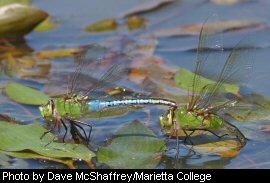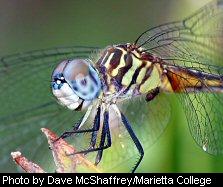

|
Beautiful Dancers: West Virginia's Dragonflies By Jennifer Wykle
Dragonflies and damselflies belong to the order of insects called Odonata . Representatives from five families of dragonflies and three families of damselflies live in West Virginia. The adults have two pairs of wings and are surprisingly maneuverable when airborne. If you have ever tried to catch one you wonder how they always seem to vanish into thin air! Of the approximately 435 species in North America, 144 of these have been documented in West Virginia. As we survey different areas and cover more ground, additional species will be added to the state list. Dragonflies and damselflies are surprisingly easy to tell apart. When perched, dragonflies hold their wings out flat to the side while most damselflies fold their wings above their body. Generally, the large eyes of the dragonflies will touch each other while damselfly eyes are smaller and spread much further apart. Dragonflies are generally larger and much stronger fliers than damselflies and can be found considerable distances from water. Damselfly flight can be very erratic and they are almost always found over water or perched on overhanging vegetation. To make discussions easier, both groups are often lumped together and called dragonflies or odonates . Dragonflies have been around a long time - about 300 million years. Fossil records reveal that some dragonflies had wingspans of nearly three feet! The dragonflies that existed with the dinosaurs 180 million years ago are virtually the same in structure as dragonflies that fly today. Like most insects, dragonflies have three life stages: the egg, larva and adult. Eggs are deposited in or around water and the larvae are fully aquatic, equipped with gills. Larvae, depending on size and food availability, prey on other insect larvae, small fish and salamanders. Depending on the species and environmental conditions, time of transformation can vary greatly. Some species may live as larvae for only a month while others may spend eight years in the water. Adult dragonflies can live from one to nine months, depending on the species. Adults are voracious predators taking insect prey while on the wing. Adults feed on a variety of flying insects such as mosquitoes, gnats and even other dragonflies. Like most groups of animals in the state, some dragonflies are extremely common while others are rare and hard to find even in their ideal habitats. They are rare in West Virginia either due to lack of appropriate habitat (the state lies on the edge of their range) or they are rare throughout their range. One such species, the Elusive Clubtail , fits the latter description. It had been considered a historically ocurring species until it was spotted last June on one of the Ohio River islands. This species is extremely rare in some areas such as Pennsylvania and Massachusetts where it is considered lost from the state's fauna. Another surprise species was discovered this past summer. A tiny bright red damselfly was found at Green Bottom Wildlife Management Area in Cabell County hovering over duckweed. Appropriately called the Duckweed Firetail , the nearest known population occurs in central Kentucky.
While a number of Odonates are hard to spot, there are many common species that can be observed on a nice sunny afternoon on the river or around your backyard pond. The Common Whitetail , with its black banded wings and white abdomen, patrols nearly all still or slow-moving bodies of water in the state. Along with this species you can find the Common Green Darner, a large dragonfly with a green thorax and blue-striped abdomen. Another common species and one of the most striking, the Ebony Jewelwing damselfly, has solid black wings with an iridescent green body. As it flutters along a variety of stream habitats, its appearance is unmistakable. Because odonates are an indicator of good water quality, they provide a measure of overall stream and wetland health. Unfortunately, habitat destruction and decreased water quality are ever growing threats here in West Virginia and around the globe. We need to preserve our aquatic areas because they are necessary for the survival of not only dragonflies, but for a wide variety of plants and animals. Dragonflies and damselflies are just one of the many unique groups of animals living here in the Mountain State. Go out and enjoy their brilliant colors and interesting flight patterns. They are a part of our state's rich biodiversity and are one of many groups that help to make our outdoor experience special. Jennifer Wykle is the DNR's state Zoologist stationed in Elkins. |
 Sometimes you don't even realize they're around. A buzz by your head or a mysterious rustle of grass is the only evidence they may give of their presence. Until one day, you're on the river fishing and one of these interesting creatures lands right on your canoe. Then there's no mistake—it's a dragonfly!
Sometimes you don't even realize they're around. A buzz by your head or a mysterious rustle of grass is the only evidence they may give of their presence. Until one day, you're on the river fishing and one of these interesting creatures lands right on your canoe. Then there's no mistake—it's a dragonfly!  The Spadderdock Darner is another rare species making its home in West Virginia. This one is hard to miss with its bright blue eyes and blue markings up and down its abdomen. It likes fishless ponds and wetland areas and has only been found in two areas of the state.
The Spadderdock Darner is another rare species making its home in West Virginia. This one is hard to miss with its bright blue eyes and blue markings up and down its abdomen. It likes fishless ponds and wetland areas and has only been found in two areas of the state.